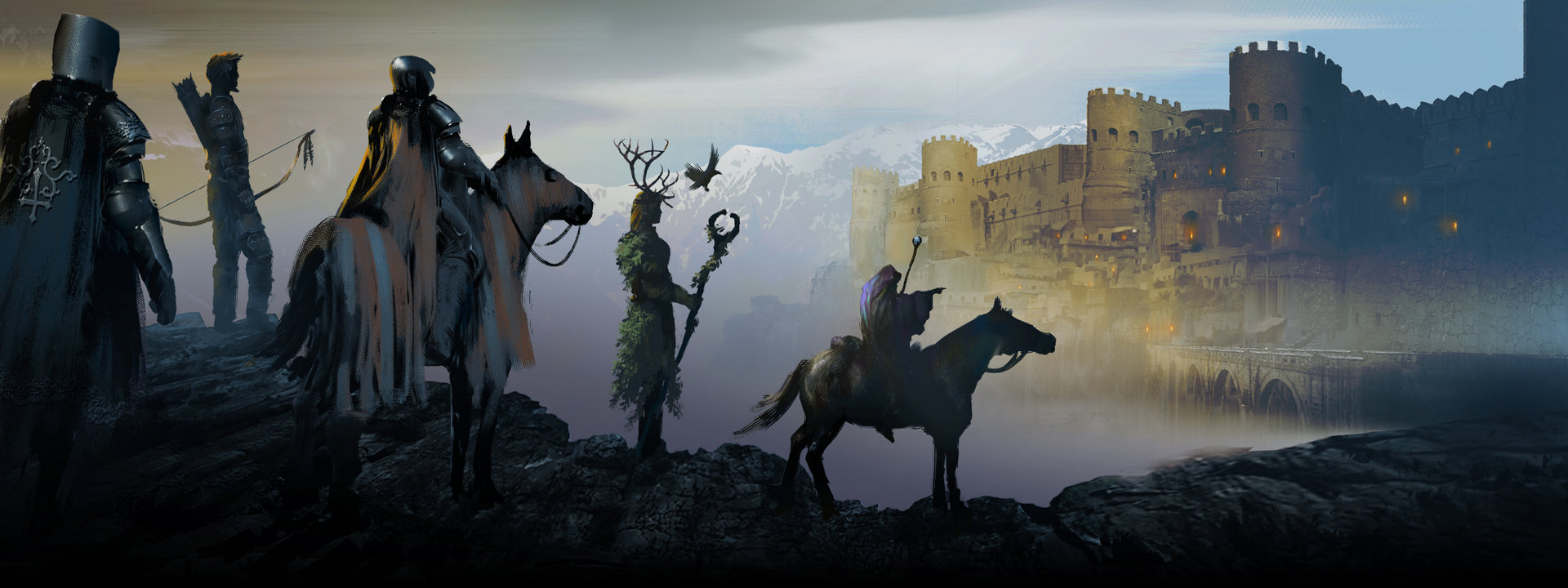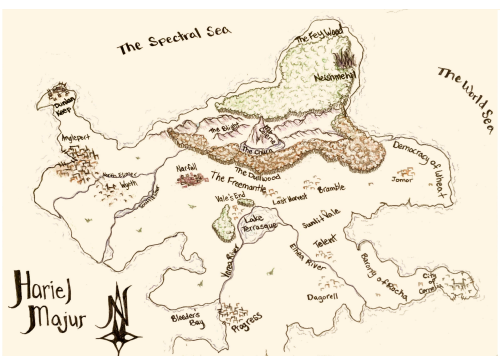Hariel Majour
"Land of Magic and Mystery..."
HARIEL MAJOUR
The lands of the largest continent on Gothenya are broken into fiefdoms, many of which serve the sovereign empire Kingdom of Wyeth (also known as the Dusklands, for the seat of the nation is the westernmost).
The seat of power in the empire, the High Throne of Wyeth, sits behind a two-hundred foot circular wall, dead center amid the largest city in the known world, Angleport (named for the extreme angles that mark its trade shores). Angleport is the only city in the world to boast an alleged population just shy of one million residents. Most of the court and advisors to the king live close to the heart of the city, only venturing to their various homelands when court is not in session.
The kingdom was not always an empire. Though ruled by a divinely chosen king, much of the actual governing was once conducted by a council of Magisters and regional lords (Dukes, Barons and the like), who operated not unlike a senate. During the dark times shortly after the Sundering, revolt tore through the kingdom. The nation lands were divided by opportunistic local lords and for many years, the line of Wyeth fell from absolute power. Thus, The Age of Destiny (marked by the divine will of the “woken” Gods) was replaced by The Age of Will (marked by the silencing of the “sleeping” Gods), threw off the yoke of theological rule.
To summarize, the Nation of Hariel was ruled by sovereign kings from the High Throne of Wyeth. The Wyeth line of succession remained unbroken for thousands of years, until the Age of Will, when it was challenged by various usurper kings, local lords given to the abandonment of divine right. The Barony of Rocha massed the Freemantle (a loose confederation of unaligned orbital states) against the last original King, Neral Wyeth the Green (so called for both his inexperience and his envy), successfully breaking the royal line for many years.
In our Current Age (Age of Will: fourteen hundred forty two), fears of the maligned Lentokki God Kings to the East paved the way for the Restoration of the Crown. The first Wyeth to hold the throne in an age was Jothan Wyeth (called “The Valid” by his detractors). A beloved war hero, Jothan hailed from the Wyeths who defended Narfell against the Goblin Horde during the Sundering. Though his ascent was oddly uneventful, many questioned it as an exploitation of the peoples’ fear of the Lentokki. When the newly reformed “senate” couldn’t come to any agreement or legislation regarding the remaining lords of the Freemantle still in open revolt, Jothan disbanded them in a non-violent, but aggressive act that many would consider a coup. Overnight, Jothan transformed the benevolent nation state into an empire of expansion, with the intent of taking the Freemantle.
The most prosperous confederate states of the Freemantle lay to the east of Angleport, and to the South of the Blight. They lay along two primary clusters of intricate trade routes. The first cluster forms the lands of THE THAW, comprised of the Free State of Lyssia (a confederacy of smaller city states, run by local lords who comprise a loose senate), and The Democracy of Wheat (self governed by proud warrior farmers called The Ibra). The second cluster, south of The Thaw (with its borders marked by the southern edge of Lake Terrasque) forms PROSPERITY(home to the more dominating Barony of Rocha, where the Baron rules from The Sunlit Vale). These petty kingdoms were able to resist Jothan, and in order to avoid a costly war, the King of Wyeth turned to the simpler lands south of Angleport (ending at The Throat). Under his rule, the Empire took the Western seaboard, along with all the territories West of the fruitful plains of the The Thaw. In turn, The Duchies and Baronies of the Vale renounced aggressions and resumed trade with the Sunset Kingdom, while maintaining a modicum of their independence.
Now, one hundred years and a three kings later, the throne is held by Clarent Wyeth, “the young.” It is also questioned (in private at least) if Clarent rules from a position of true, autocratic power, or is a puppet king, appointed by interests to the South. Possibly a pawn of the Custodians or the Grand Hassir of the Varuum himself. The kingdoms under the domain of Wyeth do not all share the joy of his ascent. Several plot to unseat the king, gaining a following based on a strong distrust of the Custodians (many of whom are ex-Varum, or at least studied in the South amidst the shadow binders who pay homage to the Club Masters of Angleport).
The free kingdoms are comprised of a variety of governing systems and bodies, some very alien to the common Gothen. The high elves of the North (The Winter Elves) retreated to their distant homelands at the far east of Hariel Majour, beyond the barrier of the Fey Wood, separating themselves from their “lesser” kin in their mystical seat of Nieshmehil. A great animosity exists between the elvish highlords (sometimes called Ice Elves as a pejorative) and their shorter, sylvan brethren (The Kelti). The dark elves (once Kelti, later transformed by the abyssal magic of the Deepening Pits into “Drow” elves, known collectively as The Qualenti) are those who revolted against the rule of Nieshmehil, and were so thoroughly defeated, they were forced to retreat to the subterranean cities of the Underdark rather than face total annihilation at the hands of their former brothers. There, in the Deepening Pits of the Undercities, they’ve grown in power to such a degree, that a planned reckoning may not be long in the future. If the Qualenti were to hear of an invasion from the East, they would likely attempt to commit their forces to the foreign invaders’ cause.
The Kelti (sometimes called “the children” as a mockery by the Winter Elves) live in the Border Fey, which guards the Fey Wood. Some brave living in the Dull Wood, as living any closer to their “noble” kin feels like salt in a open wound. SomeKelti willingly act as servants to the highlords, living in self-imposed servitude in the paradise of Nieshmehil. The high elves tolerate their “lesser” brethren at their borders, for they serve as a deterrent to those who would attempt to cross the barrier into their lands (primarily Goblinoid). There have been rumors of The Line of Isagorn (Hobgoblins) seeking out and planning an insurrection with the wild elves, as they perhaps have a mutual enemy. But though they quarrel, there still lies a bond between The Winter Elves and the Kelti that has yet to be fully broken.
The free lords of The Thaw made the mistake of allowing Goblinoids to establish colonies along the northern edges of their territories. Primarily because of the resources still in the Dull Wood, and the simple fact that most men would never dare brave their expanse. It’s a dirty and unspoken truth that these “evil” creatures are seen as little more than fodder, with the Isagorn (hobgoblin is a derogatory term) manifesting a military hierarchy, enabling them to challenge their status through conquest. No race, including the prodigious orc colonies, have expanded faster than the goblin horde. Nowhere is this more evident than in the Garrison City of Narfell. Once commanded by knights loyal to Wyeth, it fell during The Sundering to the Goblinoid Horde. It remains a garrison today, only in the employ of the Isagorn Hobgoblins.
Type
Continent
Location under
Included Locations
- Abbey of the Sacred Fulguration
- Angleport
- Baragrast
- Bramble
- Cornelia
- Dunlan Keep
- Elimer River, North and South
- Jomor
- Kings' Barrow & Monument of Aranost
- Markhan
- Mount Celene
- Narfell
- Neishmehil
- Nyrthanguul
- Prosperity
- Rocha, the Domain of
- Ruins of the First Men
- Sacrament
- Storm Reach
- Telent
- The Blight
- The Dullwood
- The Feywood
- The Freemantle
- The Grave Town of Aklun
- The Throat
- The Underdark
Included Organizations
Owner/Ruler
The Kingdom of Wyeth
Contested By
Characters in Location
Related Tradition (Primary)
Related Reports (Primary)
Related Myths
Remove these ads. Join the Worldbuilders Guild





Comments